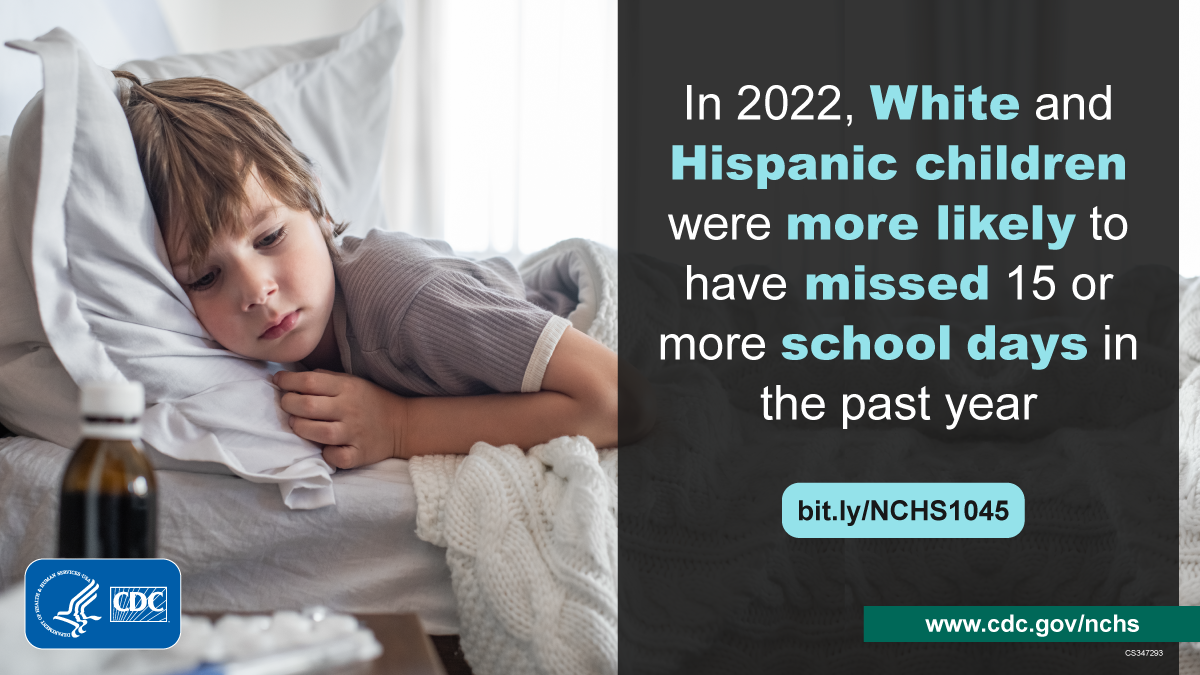Category: Data Briefs
From Numbers to Knowledge: Building America’s Mortality Report
Today, the National Center for Health Statistics (NCHS) released final mortality data for 2022 and an accompanying data brief, “Mortality in the United States: 2022.” In 2022, 3,279,857 resident deaths were registered in the United States. When it comes to understanding the health of the nation, this annual data brief provides a key piece of Read More >
Posted on byQ & A from the Report Author of Chronic School Absenteeism

Questions for Lindsey Black, Statistician and Lead Author of “Chronic School Absenteeism for Health-related Reasons Among Children Ages 5‒17 Years: United States, 2022” Q: What would you say was the most significant finding in this report? LB: There are few national data sources available to examine the prevalence of school absenteeism due to health-related reasons. Read More >
Posted on byQ & A from the Report Author of Telemedicine Use Among Physicians

Questions for Kelly Myrick, Statistician and Lead Author of “Telemedicine Use Among Physicians by Physician Specialty: United States, 2021.” Q: Why did you decide to do a report on telemedicine usage among physicians? KM: Telemedicine technology is a shared topic of interest of the coauthors. We wanted to explore telemedicine technology by physician specialty on Read More >
Posted on byNew Reports Examine Long COVID in Adults and Children

NCHS has released two new data brief reports, “Long COVID in Adults: United States, 2022,” and “Long COVID in Children: United States, 2022,” that describe the percentage of individuals who have ever had or currently have Long COVID by sociodemographic and geographic characteristics. Long COVID was defined as self-reporting the presence of symptoms for at Read More >
Posted on bySuicide and Homicide Rates Increase Among Young Americans

NCHS released a new report that uses the most recent data from the National Vital Statistics System (NVSS) to update a previous report. The report presents trends from 2001 to 2021 in suicide and homicide rates for young people ages 10‒24 and for age groups 10‒14, 15‒19, and 20‒24. Findings: After no significant change between Read More >
Posted on byNCHS Data Brief: Mental Health Treatment Among Children Aged 5–17 Years: United States, 2021

New NCHS report describes the percentage of children aged 5–17 years who have received mental health treatment in the past 12 months by selected characteristics, based on data from the 2021 National Health Interview Survey. Mental health treatment is defined as having taken medication for mental health, received counseling or therapy from a mental health Read More >
Posted on bySuicide Mortality in the United States, 2000–2020
New NCHS report presents final suicide rates from 2000 through 2020, in total and by sex, age group, and means of suicide, using mortality data from the National Vital Statistics System. This report updates a provisional 2020 report and a previous report with final data through 2019. Key Findings: Suicide rate in the United States Read More >
Posted on byStressful Life Events Among Children Aged 5–17 Years by Disability Status: United States, 2019
Questions for Heidi Ullman, Health Statistician and Lead Author of “Stressful Life Events Among Children Aged 5–17 Years by Disability Status: United States, 2019.” Q: Why did you decide to do a report on stressful life events for children with a disability? HU: Children with disabilities are an important population group that has experienced disadvantage Read More >
Posted on byConcussions and Brain Injuries in Children: United States, 2020
A new NCHS report presents national estimates of lifetime symptomatology and health care professional diagnoses of concussions or brain injuries as reported by a knowledgeable adult, usually a parent, in children aged 0–17 years using data from the 2020 National Health Interview Survey. Key Findings: In 2020, 6.8% of children aged 17 years and under Read More >
Posted on bySepsis-related Mortality Among Adults Aged 65 and Over: United States, 2019
NCHS releases new report that describes sepsis-related mortality among adults aged 65 and over by age, sex, race and Hispanic origin, and urbanicity. Key Findings: Sepsis-related death rates for adults aged 65 and over varied from 2000 through 2019 but generally declined over this period. Among adults aged 65 and over, sepsis-related death rates in Read More >
Posted on byQ & A with Author: Rural-urban Differences in Unintentional Injury Death Rates Among Children Aged 0-17: United States, 2018-2019
Questions for Matthew Garnett, Health Statistician and Lead Author of “Rural-urban Differences in Unintentional Injury Death Rates Among Children Aged 0-17: United States, 2018-2019.” Q: Can you describe what unintentional injury deaths are? MG: Unintentional injury deaths include fatal injuries that were unintended, unplanned, and did not occur on purpose. In contrast, intentional injuries include Read More >
Posted on byQ & A: Trends in Death Rates in Urban and Rural Areas: United States, 1999–2019
Questions for Sally Curtin, Health Statistician and Lead Author of “Trends in Death Rates in Urban and Rural Areas: United States, 1999–2019.” Q: Why did you decide to do a report comparing death rates in rural and urban areas? SC: In many of our reports, we have examined trends in various causes of death by Read More >
Posted on byNCHS Releases New Reports This Week on Hearing Difficulty and Back/Limb pain among U.S. Adults
NCHS Releases two new reports this week on hearing difficulty and back/limb pain. The first report presents difficulties with hearing even when using a hearing aid among U.S. adults aged 18 and over by level of difficulty and age, sex, and race and Hispanic origin. It also presents estimates of the prevalence of hearing aid Read More >
Posted on byInfluenza Vaccination in the Past 12 Months Among Children Aged 6 Months–17 Years: United States, 2019
Questions for Lindsey Black, Health Statistician and Lead Author of “Influenza Vaccination in the Past 12 Months Among Children Aged 6 Months–17 Years: United States, 2019.” Q: Is this the most recent data you have on this topic? If so, when will you release 2020 vaccination data? LB: Yes, this is the most recent data. Read More >
Posted on byMotor Vehicle Traffic Death Rates, by Sex, Age Group, and Road User Type: United States, 1999–2019
A new NCHS report provides national trends in motor vehicle traffic deaths by sex, age group, and type of road user (i.e., motor vehicle occupant, motorcyclist, pedestrian, or pedal cyclist) from 1999 through 2019 using the latest mortality data from the National Vital Statistics System. Findings: Motor vehicle traffic death rates were stable from 1999 Read More >
Posted on byDietary Supplement Use Among Adults: United States, 2017–2018
NCHS releases a new report that describes recent prevalence estimates for dietary supplement use among U.S. adults, the distribution of the number of dietary supplements used, and the most common types of dietary supplements used. Trends in dietary supplement use from 2007–2008 through 2017–2018 are also reported. Findings: Among U.S. adults aged 20 and over, Read More >
Posted on byFruit and Vegetable Consumption Among Adults in the United States, 2015–2018
A new NCHS report examines the percentage of adults aged 20 and over who consumed fruit and vegetables on a given day by sex and income in 2015–2018 and trends in fruit and vegetable consumption. Key Findings: More than two-thirds (67.3%) of adults aged 20 and over consumed any fruit on a given day, and Read More >
Posted on byUrgent Care Center and Retail Health Clinic Utilization Among Children: United States, 2019
Questions for Lindsey Black, Health Statistician and Lead Author of “Urgent Care Center and Retail Health Clinic Utilization Among Children: United States, 2019.” Q: Why did you decide to research urgent care center and retail health clinic utilization among children? LB: This is a growing segment of health care delivery system where many American’s seek Read More >
Posted on byIncreases in Prepregnancy Obesity: United States, 2016–2019
A new NCHS report presents trends in prepregnancy obesity for 2016 through 2019 by maternal race and Hispanic origin, age, and educational attainment. Trends by state for 2016–2019 and 2019 rates also are shown. Key Findings: Prepregnancy obesity in the United States rose from 26.1% in 2016 to 29.0% in 2019 and increased steadily for Read More >
Posted on byChronic Pain and High-impact Chronic Pain Among U.S. Adults, 2019
Chronic pain and chronic pain that frequently limits life or work activities, referred to in this report as high-impact chronic pain, are among the most common reasons adults seek medical care and are associated with decreased quality of life, opioid dependence, and poor mental health. This report examines chronic pain and high-impact chronic pain in Read More >
Posted on bySpecial Diets Among Adults: United States, 2015–2018
A new NCHS report released today shows the percentage of U.S. adults who, on a given day, were on any special diet and specific types of special diets in 2015–2018 and trends from 2007–2008 through 2017–2018. Key Findings: In 2015–2018, 17.1% of U.S. adults aged 20 and over were on a special diet on a Read More >
Posted on byBreakfast Intake Among Children and Adolescents: United States, 2015–2018
Questions for Ana Terry, Health Statistician and Lead Author of “Breakfast Intake Among Children and Adolescents: United States, 2015–2018.” Q: Was there a specific finding in the data that surprised you from this report? AT: It was interesting to see that the percentage of breakfast intake among adolescents was more than 20 percentage points lower Read More >
Posted on byMotor Vehicle Traffic Death Rates Among Adolescents and Young Adults Aged 15–24, by Urbanicity: United States, 2000–2018
Questions for Sally Curtin, Health Statistician and Lead Author of “Motor Vehicle Traffic Death Rates Among Adolescents and Young Adults Aged 15–24, by Urbanicity: United States, 2000–2018.” Q: Was there a specific finding in the data that surprised you from this report? SC: The finding that the difference in MVT death rates between persons aged Read More >
Posted on byReasons for Being Uninsured Among Adults Aged 18–64 in the United States, 2019
Questions for Amy Cha, Health Statistician and Lead Author of “Reasons for Being Uninsured Among Adults Aged 18–64 in the United States, 2019.” Q: Why did you decide to do a report on this topic? AC: In 2019, 14.5% of adults aged 18–64 were uninsured in the United States. Individuals without health insurance experience barriers Read More >
Posted on byPrevalence of Prescription Pain Medication Use Among Adults: United States, 2015–2018
FROM THE AUTHOR In 2015–2018, 10.7% of U.S. adults used one or more prescription pain medications in the past 30 days. Prescription pain medication use was higher among women than men overall and within each age category. Use increased with age overall and among men and women. Prescription pain medication use was lowest among non-Hispanic Read More >
Posted on by
